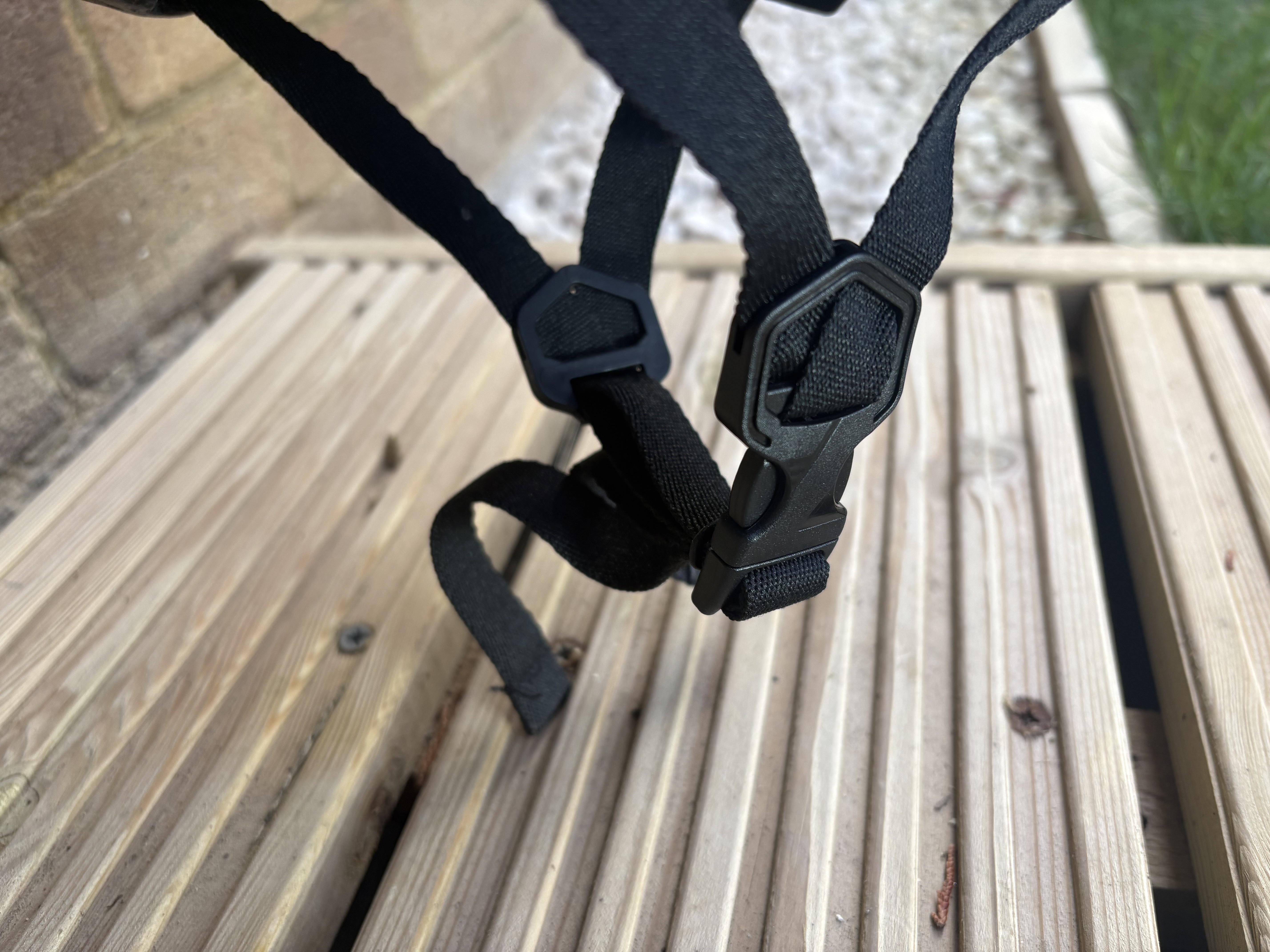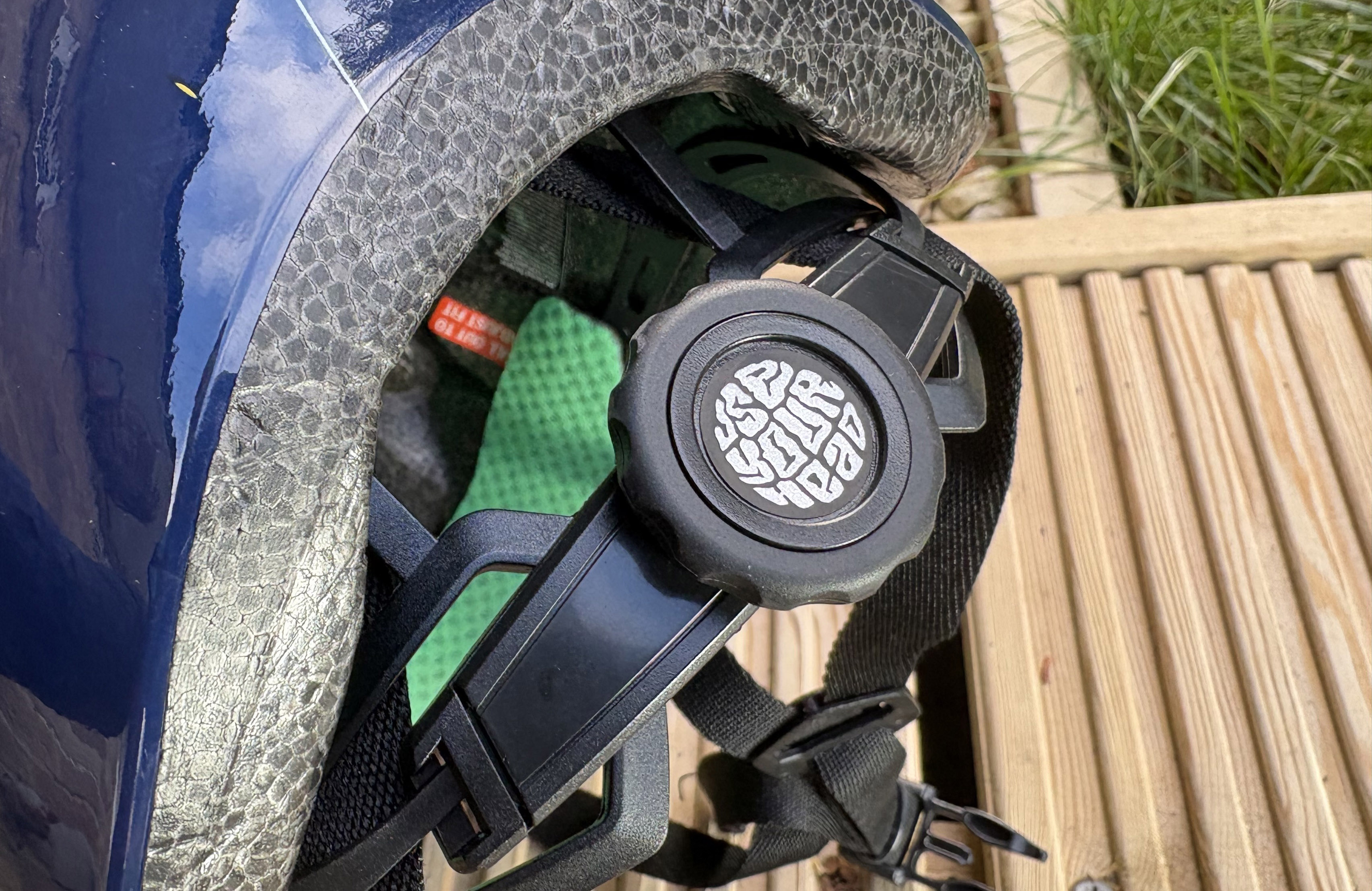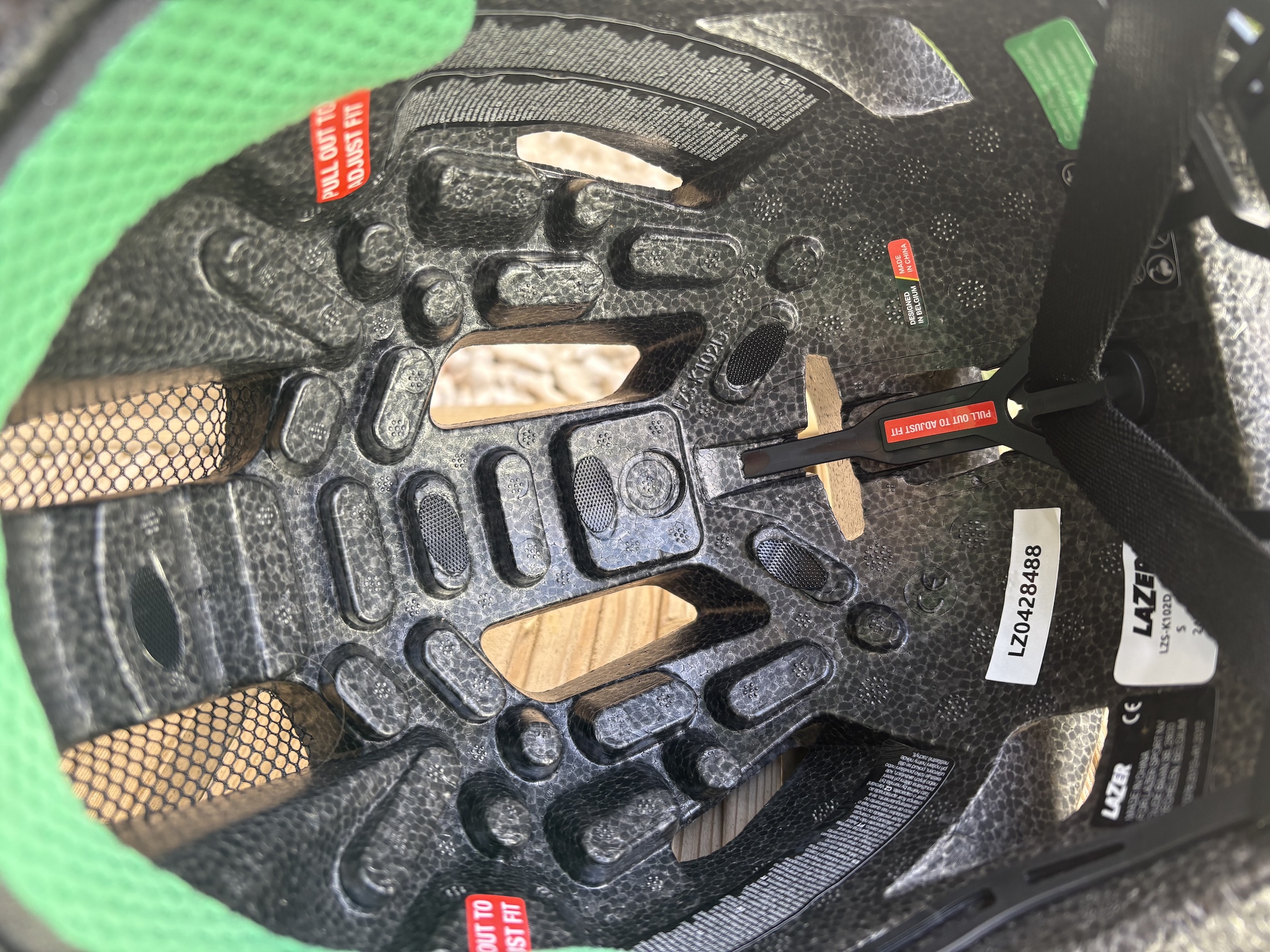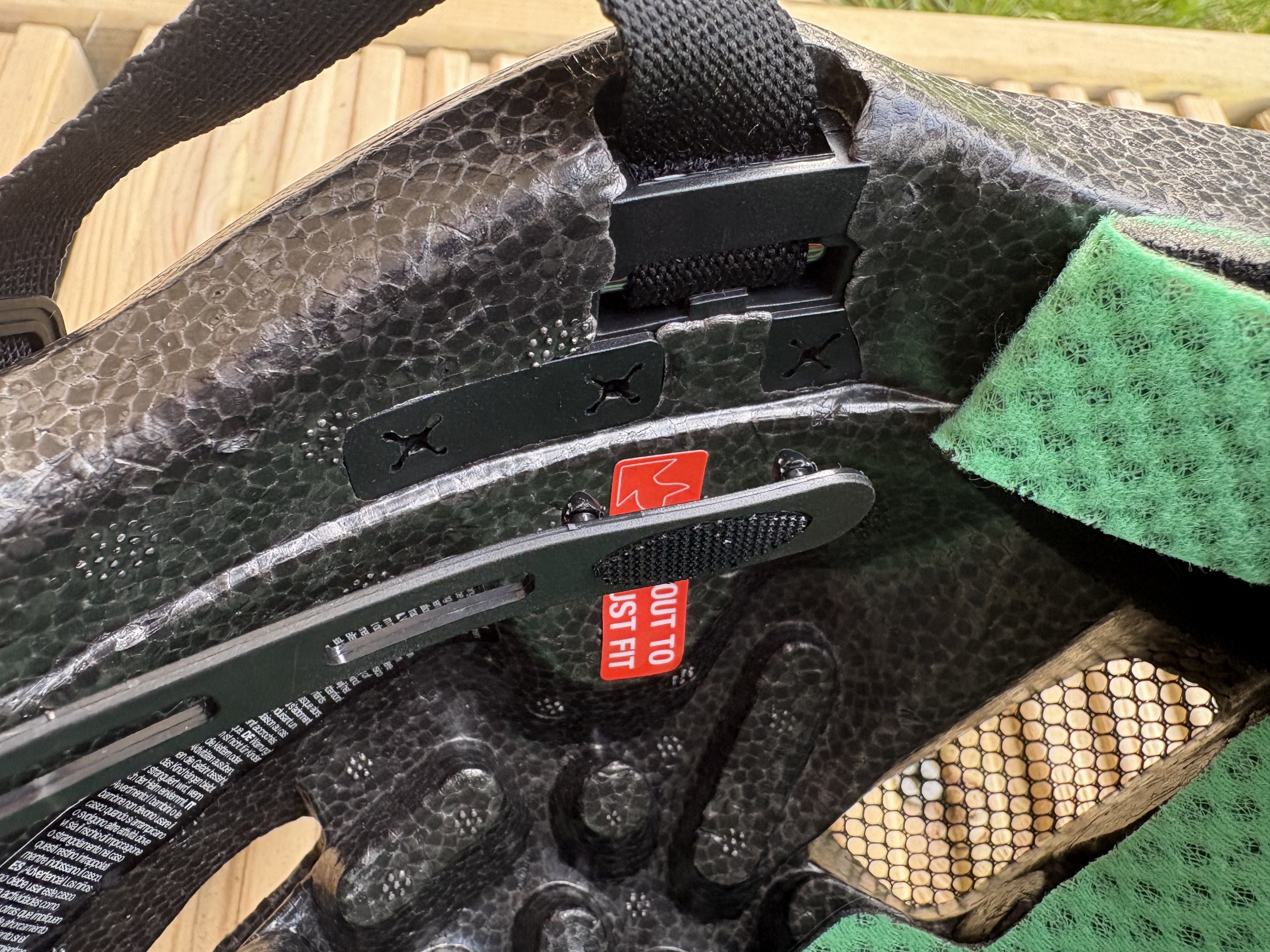Young children might not ride particularly fast, and many won’t ride in traffic, but you’ll still want to protect their heads. What parent wouldn’t. A helmet is, therefore going to be an essential item for most kids, and there’s a whole raft of things to take into consideration when looking for the best kids bike helmets.
First and foremost, they’ve got to want to wear it, and at first that means liking the look of it. If they don’t want to wear it, good luck getting them out on their bike. This Lazer Nutz KinetiCore is the space version, in dark blue with rockets, planets, and star motifs splattered around it.
Two big pads stayed in place thanks to velcro pads
(Image credit: Future)
It also comes in white with butterflies, dark green with light green blobs dotted around, pink with red hearts, dark green with fire-breathing dragons, plain bright yellow, and purple with unicorns. After all, there has to be unicorns.
The Nutz helmet is a standard build using Expanded Polystyrene (EPS) foam with a glued-on plastic shell to allow for the funky designs and give the polystyrene a little protection from minor scrapes and scratches. It is not a safety feature. Like all helmets we test, it conforms to EU standards for personal protective equipment; that’s EN1078:2012+A1: 2012.
It has nylon straps coming down either side of the ears and joining underneath where they fix together with a side pinch buckle which has been positioned below the ear, so the buckle sits on the side of the jaw, rather than directly underneath the chin.

The side-pinch buckle clips in just below the rider’s ear
(Image credit: Future)
The adjustable retention system (technically known as an occipital stabilizer) tightens with the dial at the back, pulling the fitting in by around 2.5cm (front to back) and gives a good, snug fit.
There are ten vents around the helmet with the front two featuring netting to stop insects flying in. The two side front vents aren’t actually vents as they’re filled in, they’re just there for the aesthetics. The sticker on the 360 dial is reflective, but it’s so small that I wouldn’t give it a second thought.
We tested a size small, which should fit heads that measure between 50 – 56cm around the crown of the head (the testers head measured 52cm). As a guide we measured the internal dimensions, finding it to be 16.7cm at its widest point side to side, and 20.2cm front to back. The two foam pads are positioned to sit against the rider’s forehead and over the top of their head. Both are 4mm thick

The retention dial is easy to grip and use, even with gloves on
(Image credit: Future)
On sale for £39.99, it’s no surprise the Nutz doesn’t come with MIPS as that would more than double the price, but Lazer have developed their own safety design called the Kineticore. This is what the odd shapes in the EPS are on the inside of the helmet. They’re designed to crumple on impact and help dissipate forces.
While Virginia Tech don’t rate kids helmets, Lazer’s adult helmets with Kineticore tech don’t perform as well as their helmets with MIPS in. Lazer’s top VT-rated helmet is the G1 MIPs (number 25 overall), while their top-ranked helmet with their Kineticore EPS (the Z1) is ranked 42nd overall.
Several Kineticore (adult) helmets only score three out of five stars on the VT rating, including the Tonic, Cerro, Tempo and Codax. This doesn’t make them unsafe, but it does suggest this tech doesn’t add much protection when compared to a standard helmet without dimples or shapes in the EPS.
This is all according to Virginia Tech, whose 24 impact tests measure linear acceleration and rotational velocity – both of which are linked to concussion risk – and are becoming more widely adopted in the industry.

Lazer’s Kineticore tech claims to add an extra layer of safety to their helmets
(Image credit: Future)
The straps fit snuggly to the side of the face and the retention system with 360 tightening enhances the fit. The dial is easy to use to gradually tighten and loosen the helmet, even when wearing gloves
The retention system also has 2cm of adjustment on either side of the head,. You can also adjust the rear up and down, by about one centimetre. Enough retention to keep it firmly on our tester’s head when she tipped her head down to the ground and wiggled it around.

The arms of the retention system have extra adjustability
(Image credit: Future)
Explaining the 2-4-2 rule
This is a simple technique used by coaches to teach kids and ensure they know not just how to put on a helmet correctly, but how it feels when their helmet is on correctly. The numbers refer to fingers.
2 – The number of fingers you can fit between your eyebrow and the bottom of the front of the helmet.
4 – The index and middle fingers of both hands. Hold them up in a V shape and then press them against the side of your head, the either side of your ears. This is where the helmet straps should be.
2 – Can you get two fingers undernearth your chin strap? If you can’t, it’s too tight. If you can get more in the space, it’s too loose. It’s simple and easy to remember, and once a child knows it, all you need to say is ‘2-4-2!’ and they’ll know what to check.
The helmet fitted well, and there were no complaints over discomfort, although we did find the helmet slipped back, exposing the forehead. There’s a chance that this is in part down to long hair (in a ponytail), which doesn’t provide the best grip. My daughter knows the 2-4-2 helmet fitting rule (see box), and so could easily adjust it when hitching a ride in the cargo bike, but when riding herself we’d have to stop and do it.
We could have cranked the dial up a little tighter, but I didn’t want to make it uncomfortable. The ability to feed my daughter’s ponytail between the helmet body and retention system would keep it in place better, but there’s not enough room to do so. I suspect few helmets are designed with ponytails in mind – when they absolutely should be.
One final point to mention is Lazer have a crash replacement program, giving you 50% off a new helmet if a crash damages your helmet in the first three years.
